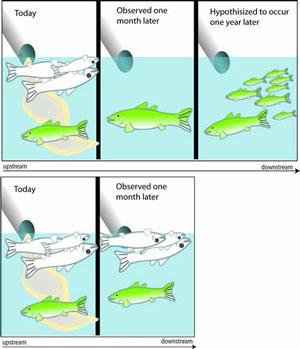Explanation of Evidence
Concept
Explanation of Evidence: Confidence in the argument for a candidate cause is increased when a post hoc mechanistic, conceptual, or mathematical model reasonably explains any inconsistent evidence.
 Figure 5-1. Explanation of Inconsistent Evidence.
Figure 5-1. Explanation of Inconsistent Evidence.
Click to view more information
Examples
Consider point source discharge of metals as a candidate cause of reduced abundance of fish and macroinvertebrates. What findings support or weaken the case for increased metal concentrations as the cause, in terms of explanation of the evidence?
- Supporting evidence: Manipulation of exposure at the site (via removal of the point source discharge) did not result in increased fish or invertebrate abundance, weakening the case for increased metals as a candidate cause. However, immediate recovery may not have occurred due to insufficient recovery time (i.e., time lags), insufficient recruitment sources, or persistence of metals in sediments. If one of these explanations is applicable to the case, it may be strong enough to reverse the negative score for manipulation of exposure at the site.
- Weakening evidence: The case for increased metals was supported only by spatial/temporal co-occurrence data, but it is discovered these data were collected using suspect methods.
How Do I Analyze Explanations?
Generally the explanations depend on the expertise and judgment of the scientists who are conducting the assessment.It is a relatively weak type of evidence, because assessors often can suggest explanations after the fact. However, thinking about possible explanations can lead to the collection of new information that could increase confidence in iterative assessments of the impairment.
- Decreased % Mayflies and Increased % Tolerant Macroinvertebrates
- Increased % DELT
- Increased Relative Weight
What Evidence Would Support or Weaken the Case for a Candidate Cause, in Terms of Explanations of Evidence?
Supports
- A credible explanation of why a type of evidence weakening the case may be incorrect, when all other types of evidence support the case.
- A credible explanation of why the case provides an unambiguous and convincing causal explanation, even when not all types of evidence for a case are consistent.
Weakens
- A credible explanation of why a type of evidence supporting the case may be incorrect, when all other types of evidence weaken the case.
- A credible explanation of why the score for a type of evidence should be reversed, thus changing a fully consistent body of evidence to one with inconsistencies.
How Do I Score the Explanations?
| Finding | Interpretation | Score |
|---|---|---|
| There is a credible explanation for any negative inconsistencies or ambiguities in an otherwise positive body of evidence that could make the body of evidence consistently supportisng. | This finding can save the case for a candidate cause that is weakened by inconsistent evidence; however, without evidence to support the explanation, the cause is barely strengthened. | + + |
| There is no explanation for the inconsistencies or ambiguities in the evidence. | This finding neither strengthens nor weakens the case for a candidate cause. | 0 |
| There is a credible explanation for any positive inconsistencies or ambiguities in an otherwise negative body of evidence that could make the body of evidence consistently weakening. | This finding further weakens an inconsistent case. However, without evidence to support the explanation, the cause is barely weakened. | - |
Helpful Tips
- Note that this type of evidence need not be scored: the important thing is to document the explanation.
- You don't have to have the data in hand, just a credible explanation for why an inconsistent type of evidence may be misleading.
- If you do collect new data relevant to explanation of inconsistencies, you may then have a stronger type of evidence—verified prediction—in the next iteration of the assessment.
